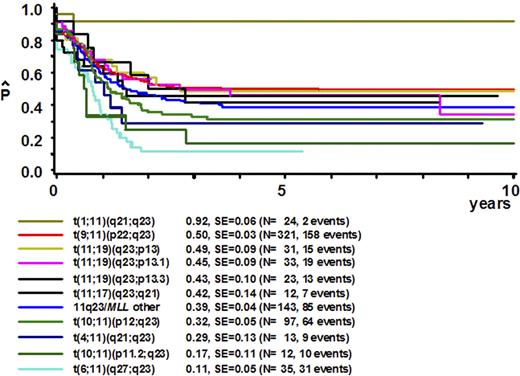A large intergroup investigation of MLL translocation partners in pediatric AML discovers low-risk star, t(1;11), confirms high-risk chromosomes 6 and 10 partners, and declares generic t11q23 insufficient for risk stratification.1
Risk-stratification of disease is a cornerstone of leukemia therapy. Rearrangements of the MLL gene on chromosomal band 11q23 are considered high-risk. Within MLL-rearranged leukemia, age, phenotype, translocation partner, and additional chromosomal aberrations are prognostic indicators in some studies.
To examine how MLL translocation partners and these other variables correlate with prognosis in pediatric acute myeloid leukemia (AML), in this issue of Blood, Balgobind and colleagues review outcomes of 756 children with confirmed MLL-rearranged AML treated on recent clinical trials of 11 collaborative groups from 15 countries.1 The 5-year event-free survival (EFS) is 44%1 and overall survival (OS) 56% in the MLL-rearranged cohort, the same as the respective medians for all AML treated after 1992 in these collaborative groups.1 Thus, generic MLL rearrangement appears to be an intermediate-risk type of pediatric AML.
Outcomes within the MLL- rearranged cohort vary significantly according to translocation partner ranging from 11% EFS in t(6;11)(q27;q23) rearrangement to 92% EFS in t(1:11)(q21;p23) rearrangement (see figure).1 In rearranged t(9;11) AML, EFS is 50%, that is, intermediate, although within the t(9;11) subset FAB M5 is a relatively favorable phenotype.1 Older age, additional cytogenetic aberrations, and leukocyte count more than 100 × 109/L are unfavorable.
The 5-year OS of 100% in the 3% of children with t(1:11)(q21;p23) is remarkable. The 1q21 partner gene, AF1q, encodes a proapototic mitochondrial membrane protein expressed in normal hematopoietic progenitors and variably expressed in AML and other cancers.2 In vitro AF1q overexpression confers resistance to doxorubicin,3 and overexpression is associated with poor prognosis in pediatric AML.4 The der MLL fusion partner forms an oncogenic protein; the der AF1q partner forms no protein.3 Comparison of the activity of der MLL fusion protein in t(1:11)(q21;p23) with those of less favorable translocations may explain their different sensitivities to therapy.
The heterogeneity of outcomes within MLL-rearranged AML implies that generic classification of AML as t(11q23) is no longer sufficient for risk stratification. However, for partner identification to become standard practice, it must be accomplished expeditiously and economically. The Balgobind study uses a combination of cytogenetics and complementary FISH and molecular techniques to identify all translocation partners; expert review is retrospective.1 An equally large collaborative investigation reported by Meyer et al uses long-distance PCR to characterize 384 pediatric and 376 adult cases of the MLL-rearranged AML or ALL.5 This method identifies all reciprocal MLL fusions and structural abnormalities and provides patient-specific PCR probes for monitoring minimal residual disease.5 If the Meyer study is validated in real time, long-distance PCR could become standard for MLL partner identification.
Event-free survival curves for patients with 11q23/MLL-rearranged pediatric AML grouped on the basis of different translocation partners. Assignment to 11q23-rearranged subgroups was based on translocation partners, as identified after central review of karyotyping. Some patients were assigned to 11q23 subgroups based on RT-PCR results only. If an MLL rearrangement was determined by FISH and the translocation partner was unkown, the patient was included in the “11q23/MLL-other” group. At least 10 patients had to be included to create a subgroup, otherwise the cases were allocated to the 11q23/MLL-other group. Patients with a t(1;11)(q21;q23) showed independent favorable outcome with overall survival at 5 years of 100% (± 0%) and an event-free survival of 92% (± 5%). Several rearrangements were identified as predictors of poor clinical outcome, including t(6;11)(q27;q23), t(10;11)(p11.2;q23), t(4;11)(q21;q23), and t(10;11)(p12;q23). See the complete figure in the article beginning on page 2489.
Event-free survival curves for patients with 11q23/MLL-rearranged pediatric AML grouped on the basis of different translocation partners. Assignment to 11q23-rearranged subgroups was based on translocation partners, as identified after central review of karyotyping. Some patients were assigned to 11q23 subgroups based on RT-PCR results only. If an MLL rearrangement was determined by FISH and the translocation partner was unkown, the patient was included in the “11q23/MLL-other” group. At least 10 patients had to be included to create a subgroup, otherwise the cases were allocated to the 11q23/MLL-other group. Patients with a t(1;11)(q21;q23) showed independent favorable outcome with overall survival at 5 years of 100% (± 0%) and an event-free survival of 92% (± 5%). Several rearrangements were identified as predictors of poor clinical outcome, including t(6;11)(q27;q23), t(10;11)(p11.2;q23), t(4;11)(q21;q23), and t(10;11)(p12;q23). See the complete figure in the article beginning on page 2489.
The purpose of risk stratification is to assign treatment according to risk of relapse or death. Probably children with t(1:11)(q21;p23) rearrangement need less treatment while those with the other rearrangements need better treatment. Unlike MLL-rearranged leukemia in adults,6 allogeneic stem cell transplantation is no better than chemotherapy in children.1 Better therapy is likely to involve agents that impair targets normally controlled by MLL such as clustered HOX homeobox genes or novel enzymatic activities of fusion proteins.7,8
Conflict-of-interest disclosure: The author declares no competing financial interests. ■


This feature is available to Subscribers Only
Sign In or Create an Account Close Modal